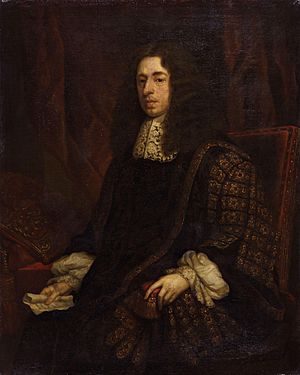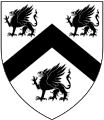Heneage Finch, 1st Earl of Nottingham facts for kids
Quick facts for kids
The Earl of Nottingham
|
|
|---|---|

The Earl of Nottingham by Sir Godfrey Kneller, Bt, c. 1680
|
|
| Lord Chancellor | |
| In office 1675–1682 |
|
| Preceded by | The Earl of Shaftesbury |
| Succeeded by | Sir Francis North |
| Lord Keeper | |
| In office 1673–1675 |
|
| Preceded by | The Earl of Shaftesbury |
| Succeeded by | Sir Francis North |
| Attorney General | |
| In office 1670–1673 |
|
| Preceded by | Sir Geoffrey Palmer, Bt |
| Succeeded by | Sir Francis North |
| Solicitor General | |
| In office 1660–1670 |
|
| Preceded by | William Ellis |
| Succeeded by | Sir Edward Turnour |
| Member of Parliament for Oxford University | |
| In office 1661–1674 Serving with Laurence Hyde
|
|
| Preceded by | Thomas Clayton John Mylles |
| Succeeded by | Laurence Hyde Thomas Thynne |
| Member of Parliament for Canterbury | |
| In office 1660–1660 Serving with Sir Anthony Aucher
|
|
| Preceded by | Sir Edward Master John Nutt |
| Succeeded by | Francis Lovelace Sir Edward Master |
| Personal details | |
| Born |
Heneage Finch
23 December 1620 Eastwell, Kent |
| Died | 18 December 1682 (aged 61) Great Queen Street, London |
| Spouses |
Elizabeth Harvey
(after 1646) |
| Parents | Sir Heneage Finch Frances Bell Finch |
| Education | Westminster School |
| Alma mater | Christ Church, Oxford |
Heneage Finch, 1st Earl of Nottingham (born December 23, 1620 – died December 18, 1682) was a very important lawyer and politician in England. He became the Lord Chancellor, which was the highest legal position in the country. His family, the Finch family, had many members who were also famous lawyers. Heneage was the oldest son of Sir Heneage Finch, who was a legal officer called the Recorder of London.
Contents
Early Life and Education
Heneage Finch was born in Eastwell, Kent, a county in England. He went to Westminster School, a well-known school, and then studied at Christ Church, Oxford University. In 1638, he joined the Inner Temple, which is one of the professional associations for barristers in London. He became a lawyer in 1645 and quickly became very successful.
Political Career
In April 1660, Heneage Finch was chosen to be a Member of Parliament for Canterbury. Soon after, he became the Solicitor General, a top legal advisor to the government. He was also made a baronet and a knight.
In May 1661, he was elected as a Member of Parliament for Oxford University. Oxford University even gave him a special degree in 1665. He continued to rise in his career, becoming Attorney General in 1670. By 1675, he reached the highest legal position, becoming Lord Chancellor. He was given the title Baron Finch in 1673 and later Earl of Nottingham in 1681.
His Role in the Popish Plot
During a confusing time known as the Popish Plot, Heneage Finch was involved in questioning witnesses. This was a period when many people believed there was a plan to harm the King. Finch was known for being fair and careful. He even had doubts about some of the stories told by witnesses. He tried to act with fairness and control during this difficult time.
Nottingham House and Kensington Palace
The building that is now Kensington Palace was originally built in the early 1600s. It was known as Nottingham House and belonged to the Earl of Nottingham. In 1689, King William III bought the house from Finch's heir. The King wanted a home near London but away from the city's smoky air because he had asthma.
At that time, Kensington was a quiet village outside London. It was easier to reach than Hampton Court. A private road was built from the house to Hyde Park Corner, wide enough for several carriages. Part of this road is still known as Rotten Row today.
The famous architect Christopher Wren made many improvements to the house. He added new parts and changed its layout. Even after these changes, it was still often called Kensington House, not a "Palace," because it felt more like a private home. The gardens at Kensington House grew fruits and vegetables for the Royal Court.
Family Life
On July 30, 1646, Heneage Finch married Elizabeth Harvey. They had six children together:
- Daniel Finch, 2nd Earl of Nottingham (1647–1730), who later became the Earl of Nottingham.
- Margaret Finch (1648–1700).
- Heneage Finch, 1st Earl of Aylesford (born around 1649–1719), who also had a successful career as a lawyer and politician.
- Elizabeth Finch (1650–1675).
- William Finch.
- Charles Finch.
Lord Nottingham passed away in London on December 18, 1682. He was buried in the church at Ravenstone. His son Daniel inherited his title.
His Legacy
Heneage Finch was highly respected by people from all political groups. They admired his honesty, fairness, and excellent speaking skills. As a lawyer, he was so good that he is still called the "father of equity" in law. Equity is a special part of law that helps make sure decisions are fair and just, especially when strict rules might lead to unfair results. One of his most important contributions to law was helping create The Statute of Frauds, which is a law about certain agreements needing to be in writing.
Images for kids
-
His daughter Elizabeth (Peter Lely)



